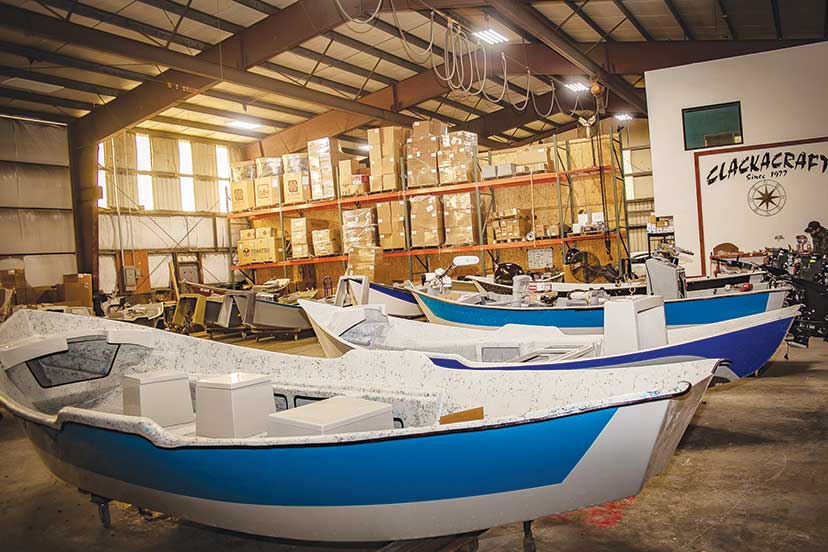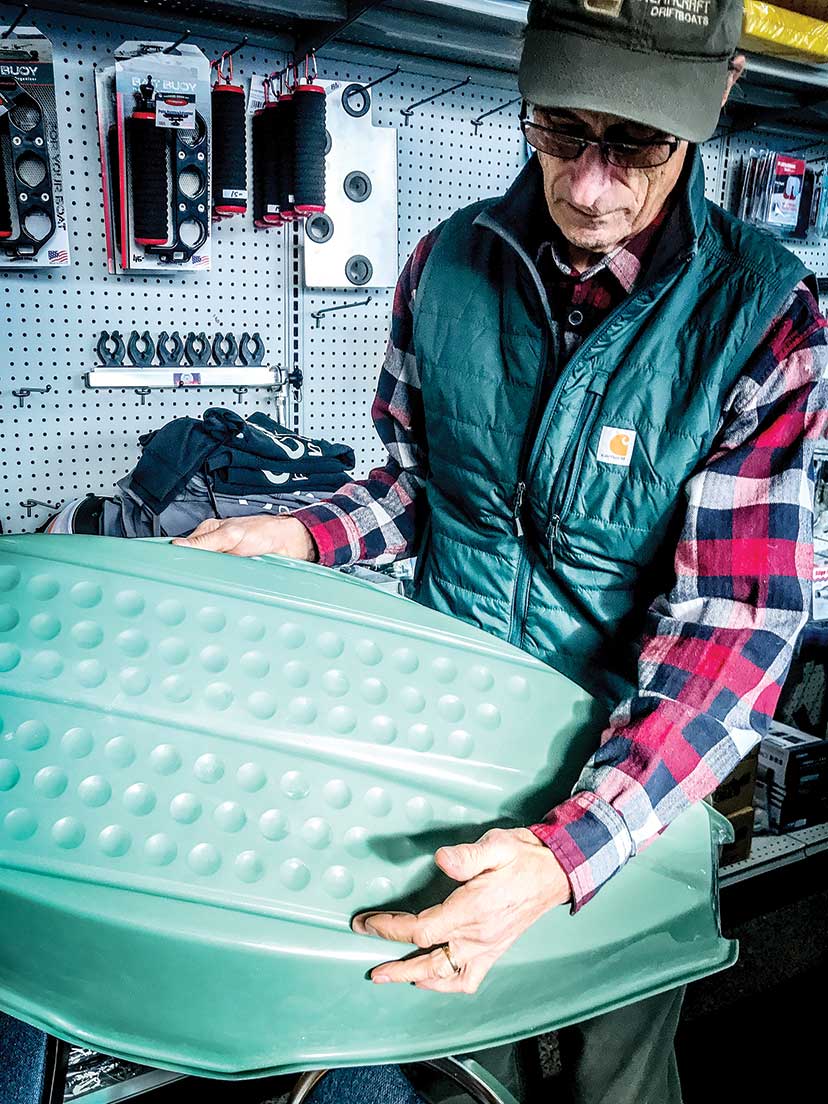ClackaCraft
Story and photos by Troy A Buzalsky
Oregon’s McKenzie River Valley is known for its white-capped mountains, natural hot springs, old-growth forests, volcanic foothills, and pristine waters. The namesake McKenzie River is an angler’s paradise that supports spring Chinook salmon, winter- and summer steelhead, as well as native rainbow, cutthroat, bull trout, and even whitefish. It also serves as the birthplace for the McKenzie River drift boat and yours truly.
Being raised along the river’s edge of the McKenzie bordering Springfield and Eugene, I was born with a flyrod in my hand. My early angling days were limited to bank access or in some cases a raft float from one bridge or boat ramp to another. My fishing life progressed to include tying flies and building rods for area anglers and guides. At the same time, my best buddy Wally’s dad owned a first-year-of-production Alumaweld drift boat (yes, he still has it), which became our high-school fishing platform, chasing steelhead while “hot-shotting” (plugging) or drift-fishing from one of the river’s more remote gravel bars.
At the time, most drift boats were wooden, with aluminum just starting to make a splash. Aluminum drift-boat manufacturers at the time included Valco, Alumaweld, Koffler, and Two Guys Fabrication (Fish-Rite), with the wooden drift-boat market being dominated by the names Keith Steel, Don Hill, and Ray’s River Dories. Of course, there were also many homemade McKenzie drifters. In fact, my high-school wood shop allowed students to build boats as part of the program. For history’s sake, the original, lightweight McKenzie River drift boat dates back to the 1920s when Veltie Pruitt milled lumber sized specifically to build a lighter, more agile drift boat.
Popular author Ruth Smeltzer once said, “To be content with mediocrity is a tragedy.” Those words have been wordsmithed by ClackaCraft Drift Boats’ pioneer, Bruce Belles, to “Good is not good enough.” It’s the reason he entered the drift-boat industry.
ClackaCraft’s founding father, Bruce Belles, was born in Oak Grove, Oregon, a pocket community to Portland that is bordered by the Willamette River to its west, the Clackamas River to its south, and a somewhat obscure Kellogg Creek to its north. As a child, these waters were a perfect playground and allowed Bruce to chase trout, bass, and even catfish.
Raised in the restaurant industry, Bruce worked for the family business until he graduated high school. The year was 1969, and Bruce drew draft card 1A, which meant he was at the top of the list with an almost certain Vietnam assignment. Bruce immediately enlisted in the Oregon Air National Guard and served as a jet-aircraft mechanic for nine years.
While pulling double-duty with the National Guard and the family business, Bruce stayed busy enough to stay out of trouble, something he couldn’t in high school. In the early ‘70s Bruce’s dad decided to close up shop and go into boat building. This led them to Port Townsend, Washington, where they bought a boat mold for a 41-foot trawler and were given instructions on the fine art of boat building. From there they set up shop in Clackamas, Oregon, and today the original 8,400-square-foot building is one of four ClackaCraft Drift Boats’ facilities.
ClackaCraft operates out of four buildings that make up its molding, rigging and welding, and sales operations. Here in the rigging room drift boats and power drifters are getting their final rigging before being delivered to customers.
Originally under the name Belles Marine, Inc., the first phase of boat building included a total of six 41-foot, full-displacement commercial-fishing trawlers. All are still plying the waters of Oregon, Washington, and Alaska as we speak. Due to a commercial-fishing moratorium, the effects of the economic recession, and the passing of Bruce’s father, Bruce was forced to stave off starvation and make a business transition. Enter the ClackaCraft drift boat.
Having built a wooden drift boat in his high-school days, Bruce already had the bones for a fiberglass drift boat. “To build a boat you start with a ‘Master Male’ that is used to build the female mold,” explains Belles. From this original mold, the first ClackaCraft drift boat, a 16-foot-long by 48-inch-wide McKenzie River High Side was born.
At the time, fiberglass drift boats were a new concept, being called “Tupperware” boats by the die-hard wood and aluminum users. But this didn’t slow Bruce down, as he continued to pioneer what would end up being the largest and most successful drift-boat manufacturer in the world.
Success was not instant for ClackaCraft. In fact, Bruce initially struggled in the local market, which again was dominated with a growing fleet of aluminum and wood drift boats and manufacturers. Bruce changed strategies and started targeting additional markets, which included Idaho, Montana, Colorado, and Wyoming. In no time at all ClackaCraft was selling as fast as they could build. Bruce laughs, “Back then we literally had to back into the Pacific Northwest market.” Forty-five years later ClackaCraft is a force to be reckoned with.
It’s been a long float since those days of the ‘70s and ClackaCraft has established itself as a true top-notch manufacturer in the industry. Belles contributes this to “Slow controlled growth and staying successfully busy.” I think it’s fair to say, having a marketing motto that proclaims, “Fear No Rock,” has also helped earn ClackaCraft and its fiberglass hull a seat at the table when it comes to a shallow-running, whitewater-capable watercraft.
The fiberglass drift boat is uniquely different than its current counterparts, which today include primarily aluminum, wooden, and plastic composites. Fiberglass drift boats have a few features that separate them from the competition, including being lighter, warmer, quieter, and slipperier when sliding over rock than aluminum or wooden boats. They also tend to row effortlessly, and part of this is due to ClackaCraft’s unique design features.
Early generations of ClackaCraft drift boats were styled after the original McKenzie River models. Belles and his design team held to their belief that “being good was not good enough” and incorporated several design features that made the boat perform even better on the water. These include the Tunnel Hull, the parallel-chine tracking channels, and the Gulfstream Bottom.
The Tunnel Hull is ClackaCraft’s computer-designed water channel that runs from the transom to mid-keel on the boat’s bottom. This unique tunnel directs water under the boat which allows for effortless rowing. The tracking channels were added to the inside of each chine and act as reverse keels, keeping the boat inline without the inherent liability of a squared chine.
Another breakthrough technology for ClackaCraft is the Gulfstream Bottom. Looking for ways to give the boat more buoyancy which would translate to enhanced maneuverability, Belles and his team incorporated a series of dimples over the boat’s bottom. Likening this to a properly engineered golf ball, these dimples allow the air to pocket while the boat’s bottom glides over the laminar flow of the water. “ClackaCraft’s Gulfstream Bottom, Tunnel Hull, and Tracking Channels provide the finest-handling boat available, and there are plenty of satisfied users who would agree,” exclaims Belles.
Founder and ClackaCraft Owner Bruce Belles uses a micro hull to help show off the unique ClackaCraft bottom, including Tunnel Hull, Gulfstream Bottom, and the tracking channels that he is pointing out.
ClackaCraft operates out of four buildings that make up its molding, rigging and welding, and sales operations.
Early concerns of fiberglass not being an acceptable substrate for a drift boat were quickly dispelled, and the motto, “Fear No Rock,” righteously resonated so much that owners have used the tagline as a body tattoo. Belles explains, “First off, ClackaCraft boats are overbuilt, to guarantee strength and on-the-water safety.” Each ClackaCraft boat comes with a transferable lifetime warranty against bottom puncture, and with over 10,000 boats sold to date, ClackaCraft estimates it repairs one, sometimes two, bottom punctures per year. “Most of our repairs come from the daily user, pro-staff, or river guide who hits the same rock time and time again. Over time, these strikes finally require service,” shares Belles.
Bruce proudly says, “In some ways, you could even call the ClackaCraft hull bulletproof.” To prove the point, years ago Belles and a few buddies decided to fire a .357 Magnum into one of their drift boats (A cartoon in my head says, “Hold my beer and watch this.”). Belles aimed and pulled the trigger; the bullet struck the chine and ricocheted over his head, narrowly missing him and his buddies. The boat suffered only minor damage and was still 100% water worthy. Bruce suggests to NOT try this yourself!
There are no trade secrets when it comes to manufacturing a ClackaCraft Drift Boat, but Bruce will quickly tell you, “We only want to see the drift boat once—at the point of sale.” Quality construction and being overbuilt are hallmarks at ClackaCraft, and once delivered, they rarely see them again, except when floating down the river.
To make a signature ClackaCraft it all starts with the making of the mold, which serves as the foundation for that model’s hull. The female (receiving) mold is first coated with a release wax. From there the mold is gel coated for color and graphic design. Gel coat is a pigmented thermosetting polymer that provides the high-quality exterior finish. ClackaCraft allows as many as three colors in its builds, and they change their color offerings to align with the automotive industry’s color palettes. Collectively, for a three-color design they offer 16 top-trim colors, 16 mid-trim colors, and five bottom-trim colors. I’m not that good at math, but it’s fair to say there are hundreds and hundreds of color combinations to choose from.

This 17-foot Magnum Power Drifter features a popular center console. ClackaCraft master craftsman Jason Leonard makes some final electrical connections. This boat includes full electronics, high-end stereo, and a bow-mounted trolling motor with a 36V lithium battery. When delivered, it will be a low-water, fish-catching machine.
Once the gel coat is cured, the boat is then laid with a resin-soaked, fine fiberglass mat followed by 24-ounce, large-weave Roven Woven fiberglass. Key areas receive additional material for strength. Next, the already manufactured interior components are laminated into place. These include the floors, seat bases and boxes, gunnel trays, rod holders, fly braces, and anchor tracking. Once the interior components are fully installed, the boat’s interior receives a Zolatone-like gel-coat finish. After the hulls are completed, they go in for final rigging at one of two area facilities.
ClackaCraft also has a trailer division, building trailers specifically for their line of drift boats as well as their Magnum Power Drifter. The trailer is manufactured from welded ⅛-inch steel tubing. Once fabricated, the trailers are dip-galvanized to guarantee a long and trouble-free life. Trailers are available with galvanized or custom aluminum wheels and feature spring-loaded, greased wheel bearings. Drift-boat trailers have two bunk rollers whereas the Magnum Power Drifter trailer utilizes three rollers and incorporates a smart, walkaround, diamond-plate bow feature. Trailers are available with torsion springs or leaf springs and finished off with a sturdy winch brace, spare tire, waterproof lighting, and built-in tie-downs. ClackaCraft also offers an aluminum trailer option.
Forty-five years has seen lots of water under the “tunnel hull” at ClackaCraft, but today they can safely declare that they have sold more drift boats in the world than any other manufacturer…and quite possibly more than all manufacturers combined. They do this from their Clackamas, Oregon, and Idaho Falls, Idaho, locations, and through their Alaska dealer, Alaska Raft and Kayak. Although they have faced two large-scale economic downturns including the 1981-82 and 2007-09 recessions, and in the ‘80s suffered a devastating fire in their manufacturing facility that destroyed their boat molds, they remarkably emerged stronger and smarter. Belles is also quick to point out that interestingly, the recent pandemic has been a shot in the arm (pun intended) for the boating industry. He says, “We can hardly keep up.”
Today, ClackaCraft offers a total of six drift-boat models including the Eddy, 16-foot Big Eddy, 16-foot Standard Side, 16-foot High Side, 16-foot Low Profile, and the granddaddy 18-foot ClackaMAX. They also have a specialty line that includes the 10-foot Don Hill Classic Pram and the 15-foot Headhunter Skiff II 360. And finally, a boat turning heads and keeping the riggers busy at ClackaCraft, the 17-foot Magnum Power Drifter, a remake from the past that’s taking shallow rivers by storm.

This 17-foot Magnum Power Drifter features a popular center console. ClackaCraft master craftsman Jason Leonard makes some final electrical connections. This boat includes full electronics, high-end stereo, and a bow-mounted trolling motor with a 36V lithium battery. When delivered, it will be a low-water, fish-catching machine.
Bruce Belles is not your typical founder, President, owner, and CEO by any means. When you meet Bruce, you will likely find him wearing tattered Carhartts, layers of well-worn undershirts topped with flannel and even a puffy jacket, and a well-seasoned ball cap; all evidence that he’s still a working man at the shop. Over his life Bruce has fished throughout the Pacific Northwest, including multiple trips into Alaska’s waters. He’s fished Cuba and Christmas Island for bonefish, GTs, and tarpon, and landed a 62-pound king salmon on Oregon’s Trask River. But he is most at home while center-pin float fishing in his local waters. And when not working at the shop, delivering drift boats, or fishing, you just might catch him polishing his 1970 British Racing Green Jaguar E Type, a hobby he and I collectively share. For more information on ClackaCraft boats go to: clacka.com.
Troy Buzalsky is the Boats columnist for Fish Alaska magazine, and when not writing about boats he can likely be found chasing fish in the Pacific Northwest and the 49th state and writing about those adventures. Troy can be reached at troybuz@comcast.net.




